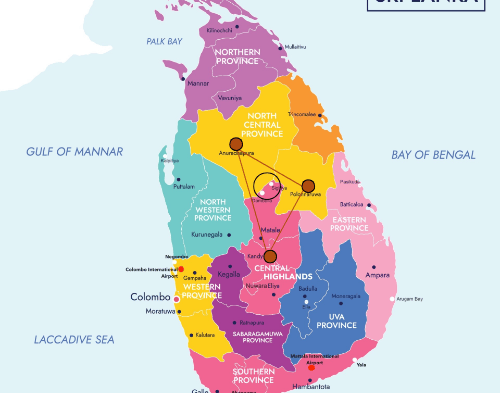Sri Lanka’s Cultural Triangle: A Journey Through Ancient Kingdoms
Sri Lanka’s Cultural Triangle is more than just ruins—it’s a journey through time. Whether you’re climbing Sigiriya at sunrise, meditating beside ancient stupas, or witnessing Kandy’s vibrant festivals, this region offers an unforgettable experience.
Sri Lanka’s Cultural Triangle is a UNESCO-listed treasure trove of ancient cities, sacred temples, and archaeological wonders. This region, formed by the historic cities of Anuradhapura, Polonnaruwa, and Kandy, offers a fascinating glimpse into the island’s rich heritage, spanning over 2,500 years of civilization.
What is the Cultural Triangle?
The Cultural Triangle connects three key historical capitals of Sri Lanka:
Anuradhapura – The first ancient kingdom (4th century BCE)
Polonnaruwa – The medieval capital (11th–13th century CE)
Kandy – The last royal kingdom (15th–19th century CE)
These sites, along with Sigiriya and Dambulla, form a triangular zone packed with UNESCO World Heritage Sites, showcasing Sri Lanka’s Buddhist, Hindu, and colonial influences.
Key Highlights of the Cultural Triangle
1. Anuradhapura: The Sacred Ancient Capital
Sri Maha Bodhi – The world’s oldest documented tree (grown from a cutting of Buddha’s enlightenment tree).
Ruwanwelisaya Stupa – A massive white dagoba built in 140 BCE.
Jetavanaramaya – One of the tallest ancient brick structures in the world.
Why Visit? Anuradhapura is a living pilgrimage site where monks still chant in ancient monasteries.
2. Polonnaruwa: The Medieval Masterpiece
Gal Vihara – Stunning rock-carved Buddha statues.
Royal Palace of King Parakramabahu – A grand ruin showcasing advanced hydraulic engineering.
Lankatilaka Temple – A towering brick shrine with intricate carvings.
Why Visit? Polonnaruwa offers well-preserved ruins, ideal for history lovers and photographers.
3. Kandy: The Last Kingdom
Temple of the Sacred Tooth Relic – Houses Buddha’s tooth, a revered relic.
Kandy Esala Perahera – A grand annual festival with dancers, drummers, and elephants.
Royal Botanical Gardens – A lush escape with rare tropical plants.
Why Visit? Kandy blends history with living traditions in a scenic hill-country setting.
4. Sigiriya: The Lion Rock Fortress
The Frescoes – Ancient paintings of celestial maidens.
Mirror Wall – A polished wall with 1,000-year-old graffiti.
Lion’s Paw Entrance – The iconic gateway to King Kashyapa’s palace.
Why Visit? Sigiriya is often called the "Eighth Wonder of the World" for its engineering marvel.
5. Dambulla: The Golden Cave Temple
Five Caves with Buddha Statues – Over 150 golden statues and murals.
Panoramic Views – Overlooking Sigiriya and the surrounding plains.
Why Visit? A spiritual retreat with awe-inspiring religious art.
Why is the Cultural Triangle Important?
UNESCO Recognition – Multiple World Heritage Sites within a small region.
Spiritual Significance – A major Buddhist pilgrimage route.
Architectural Brilliance – Ancient stupas, palaces, and irrigation systems showcase advanced engineering.
Travel Tips for Exploring the Cultural Triangle
✔ Best Time to Visit – November to April (dry season).
✔ Transport – Rent a car or hire a tuk-tuk for flexibility.
✔ Ticket Costs – Foreign tourists pay higher entrance fees (e.g., Sigiriya ~$30).
✔ Dress Code – Cover shoulders and knees at temples and wear preferably white especially in Kandy.





